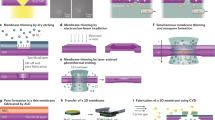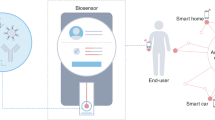Abstract
Advances in materials chemistry offer a range of nanostructured shapes and textures for building new biosensors1,2,3,4,5,6,7,8,9,10. Previous reports have implied that controlling the properties of sensor substrates can improve detection sensitivities, but the evidence remains indirect11,12,13. Here we show that by nanostructuring the sensing electrodes, it is possible to create nucleic acid sensors that have a broad range of sensitivities and that are capable of rapid analysis. Only highly branched electrodes with fine structuring attained attomolar sensitivity. Nucleic acid probes immobilized on finely nanostructured electrodes appear more accessible and therefore complex more rapidly with target molecules in solution. By forming arrays of microelectrodes with different degrees of nanostructuring, we expanded the dynamic range of a sensor system from two to six orders of magnitude. The demonstration of an intimate link between nanoscale sensor structure and biodetection sensitivity will aid the development of high performance diagnostic tools for biology and medicine.
This is a preview of subscription content, access via your institution
Access options
Subscribe to this journal
Receive 12 print issues and online access
$259.00 per year
only $21.58 per issue
Buy this article
- Purchase on Springer Link
- Instant access to full article PDF
Prices may be subject to local taxes which are calculated during checkout





Similar content being viewed by others
References
Aizawa, M. & Buriak, J. M. Nanoscale patterning of two metals on silicon surfaces using an ABC triblock copolymer template. J. Am. Chem. Soc. 128, 5877–5886 (2006).
Chai, J., Wang, D., Fan, X. & Buriak, J. M. Assembly of aligned linear metallic patterns on silicon. Nature Nanotech. 2, 500–506 (2007).
Cui, Y. & Lieber, C. M. Functional nanoscale electronic devices assembled using silicon nanowire building blocks. Science 291, 851–853 (2001).
Henzie, J. et al. Nanofabrication of plasmonic structures. Annu. Rev. Phys. Chem. 60, 147–165 (2009).
Kline, T. R. et al. Template-grown metal nanowires. Inorg. Chem. 45, 7555–7565 (2006).
LeMieux, M. C. et al. Self-sorted, aligned nanotube networks for thin-film transistors. Science 321, 101–104 (2008).
Lu, W. & Lieber, C. M. Nanoelectronics from the bottom up. Nature Mater. 6, 841–850 (2007).
Mirkovic, T. et al. Hinged nanorods made using a chemical approach to flexible nanostructures. Nature Nanotech. 2, 565–569 (2007).
Nicewarner-Pena, S. R. et al. Submicrometer metallic barcodes. Science 294, 137–141 (2001).
Zhu, J. et al. Optical absorption enhancement in amorphous silicon nanowire and nanocone arrays. Nano Lett. 9, 279–282 (2009).
Gasparac, R. et al. Ultrasensitive electrocatalytic DNA detection at two- and three-dimensional nanoelectrodes. J. Am. Chem. Soc. 126, 12270–12271 (2004).
Hahm, J. & Lieber, C. M. Direct ultrasensitive electrical detection of DNA and DNA sequence variations using nanowire nanosensors. Nano Lett. 4, 51–54 (2004).
Park, S. J., Taton, T. A. & Mirkin, C. A. Array-based electrical detection of DNA with nanoparticle probes. Science 295, 1503–1506 (2002).
Lahav, M., Weiss, E. A., Xu, Q. & Whitesides, G. M. Core-shell and segmented polymer-metal composite nanostructures. Nano Lett. 6, 2166–2171 (2006).
Love, J. C. et al. Formation and structure of self-assembled monolayers of alkanethiolates on palladium. J. Am. Chem. Soc. 125, 2597–2609 (2003).
LaVan, D. A., George, P. M. & Langer, R. Simple, three-dimensional microfabrication of electrodeposited structures. Angew. Chem. Int. Ed. 42, 1262–1265 (2003).
Fang, Z. & Kelley, S. O. Direct electrocatalytic mRNA detection using PNA-nanowire sensors. Anal. Chem. 81, 612–617 (2009).
Lapierre, M. A., O'Keefe, M., Taft, B. J. & Kelley, S. O. Electrocatalytic detection of pathogenic DNA sequences and antibiotic resistance markers. Anal. Chem. 75, 6327–6333 (2003).
Lapierre-Devlin, M. A. et al. Amplified electrocatalysis at DNA-modified nanowires. Nano Lett. 5, 1051–1055 (2005).
Egholm, M. et al. PNA hybridizes to complementary oligonucleotides obeying the Watson-Crick hydrogen-bonding rules. Nature 365, 566–568 (1993).
Ratilainen, T. et al. Thermodynamics of sequence-specific binding of PNA to DNA. Biochemistry 39, 7781–7791 (2000).
Ludwig, J. A. & Weinstein, J. N. Biomarkers in cancer staging, prognosis and treatment selection. Nat. Rev. Cancer 5, 845–856 (2005).
Munge, B., Liu, G. D., Collins, G. & Wang, J. Multiple enzyme layers on carbon nanotubes for electrochemical detection down to 80 DNA copies. Anal. Chem. 77, 4662–4666 (2005).
Zhang, Y. C., Pothukuchy, A., Shin, W., Kim, Y. & Heller, A. Detection of similar to 103 copies of DNA by an electrochemical enzyme-amplified sandwich assay with ambient O-2 as the substrate. Anal. Chem. 76, 4093–4097 (2004).
Möller, R., Powell, R. D., Hainfeld, J. F. & Fritzsche, W. Enzymatic control of metal deposition as key step for a low-background electrical detection for DNA chips. Nano Lett. 5, 1475–1482 (2005).
Acknowledgements
We wish to acknowledge Genome Canada, the Ontario Ministry of Innovation and Research, the Ontario Centres of Excellence, Ontario Institute for Cancer Research, Canada Foundation for Innovation, Canadian Institutes of Health Research, and NSERC for their support of this work. We also acknowledge X. Sun for his contributions to the optimization of electrodeposition conditions.
Author information
Authors and Affiliations
Contributions
L.S., Z.F., E.H.S. and S.O.K. conceived and designed the experiments; L.S. and Z.F. performed the experiments; L.S. and Z.F. analysed the data. All authors discussed the results and co-wrote and commented on the manuscript.
Corresponding authors
Supplementary information
Supplementary information
Supplementary information (PDF 422 kb)
Rights and permissions
About this article
Cite this article
Soleymani, L., Fang, Z., Sargent, E. et al. Programming the detection limits of biosensors through controlled nanostructuring. Nature Nanotech 4, 844–848 (2009). https://doi.org/10.1038/nnano.2009.276
Received:
Accepted:
Published:
Issue Date:
DOI: https://doi.org/10.1038/nnano.2009.276
This article is cited by
-
Organic electrochemical transistors as on-site signal amplifiers for electrochemical aptamer-based sensing
Nature Communications (2023)
-
A Systemic Review on the Synthesis, Characterization, and Applications of Palladium Nanoparticles in Biomedicine
Applied Biochemistry and Biotechnology (2023)
-
Fractal Growth of Giant Amphiphiles in Langmuir-Blodgett Films
Chinese Journal of Polymer Science (2022)
-
Breaking the barrier to biomolecule limit-of-detection via 3D printed multi-length-scale graphene-coated electrodes
Nature Communications (2021)
-
Novel nucleic acid origami structures and conventional molecular beacon–based platforms: a comparison in biosensing applications
Analytical and Bioanalytical Chemistry (2021)



